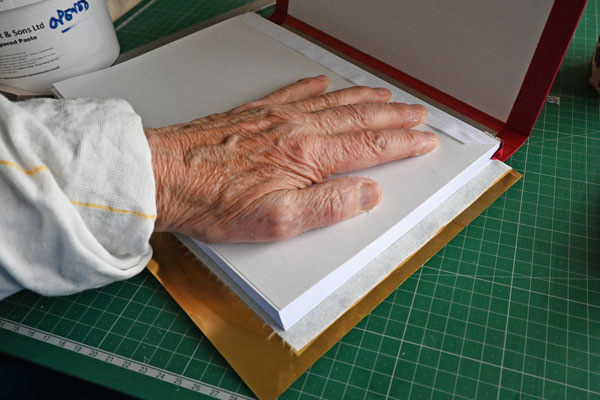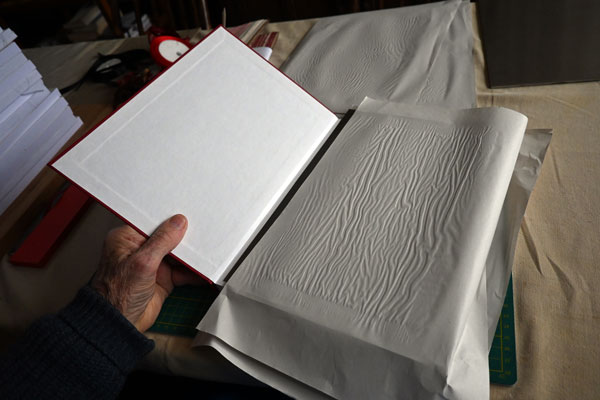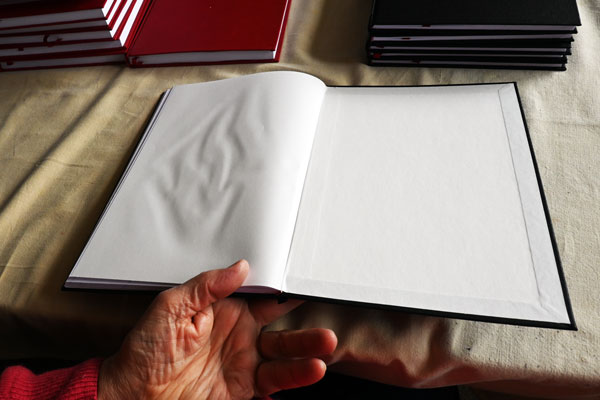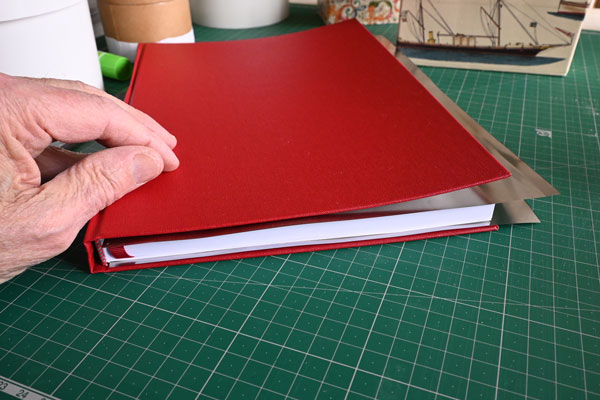
The bottom end paper of a book (out of sight) has been pasted down ~
Above it there is a thin sheet of brass ~
Above that a sheet of absorbent paper ~
Above that the book block is being prepared for the second paste-down
When I was learning bookcraft at college we used thin sheets of tin-plated steel which were called tins. They provided a waterproof barrier to prevent damp from penetrating to places where it was undesirable. Most usually the main use was to insert the tin between the covers and text of books after paste-down of endpapers.
Tins were used by all bookbinders, and the word tin was commonly used in bookcraft textbooks of the time. The tins were actually made of tin plate, another common material frequently used for making toys and for canning goods. The latter use survives to this day. I have emboldened bookbinders' tins to distinguish my descriptions from baked-bean tins. In either case the material is the same: thin steel with an even thinner coating of tin (and sometimes lacquer on top of that). The steel provides strength ~ the tin (and lacquer) prevents rust and corrosion. Tin ~ on its own ~ is not strong enough ~ and too expensive and rare for daily use.
Tins was ~ is ~ a misnomer. From now on ~ to avoid any confusion on this website ~ I am going to call the bookbinders' tool thins. This is not 'just to be awkward' but I need to recognize that few people these days know the origin of the bookbinding word tins ~ and those that do will most likely be using something other than tinplate ~ so why not call it something similar and appropriate?
Nowadays, in my classes, and also here on this site, I sometimes call then thins ~ but I don't think anyone will know what thins are or why they exist. So here are a few words which may be interesting to those who have browsed over to this page.

The main use of tins (thins) in bookcrafts is to protect the leaves of a book from the dampness of the boards as they are covered with leather ~ or the plain or decorative end-papers.


Thins ~ tins ~ must be waterproof. They must also be thin ~ since they will add unwanted fatness to the book as it dries ~ the extra width can thus become permanent. Thin also suggests flat and not too wrinkled ~ cockled ~ creased ~ bent ~ since these failings can transfer their imperfections to the paper being dried. They must also be clean ~ dirt ~ grease ~ printing ink ~ glazed paper coating ~ newspaper ~ can all transfer unwanted smudges.

I doubt if anyone makes or sells the tin-plated-steel version if tins anymore ~ a good thing too. The ones I used had paste spilt on them (by someone else, of course) which either transferred itself to my job or rusted overnight to cause brown stains when next pressed up against my (otherwise pristine) work.
Some old books suggest that some trimming can be done using tins as the cutting mat. Such practice has the advantage of negligible thickness compared with a cutting mat. The disadvatnges being that it will likely spoil the blade and the tin ~ leading to rust of it is a tinplate tin. Edith Diehl ~ I think it was ~ suggests using a zinc for this. Zinc is another grey metal that can be rolled out to be very thin. It is softer than tinplate ~ and most similar metals ~ and would be less hard on the knife blade. I doubt if any reader knows how or where to get som thin sheets of zinc. I must try to find out.
Continued on [125335] Also see [125336]